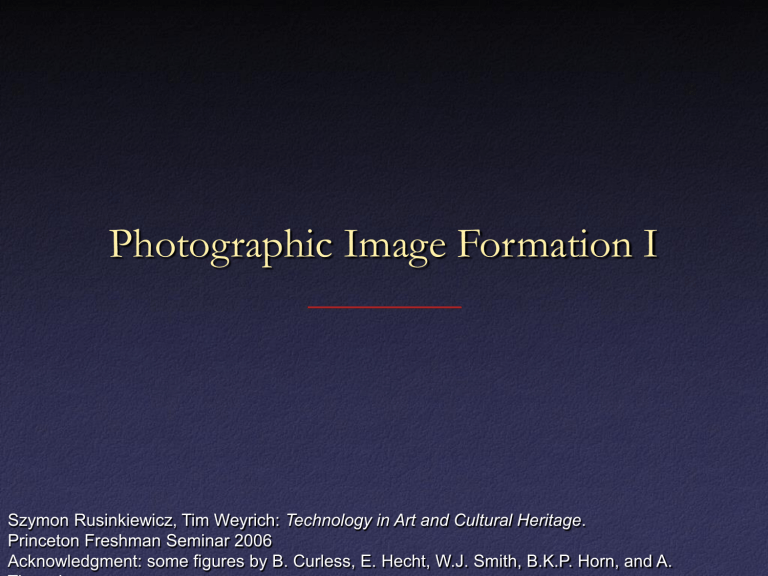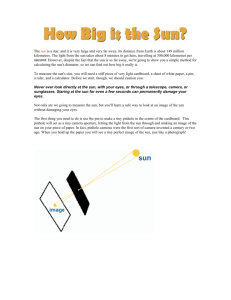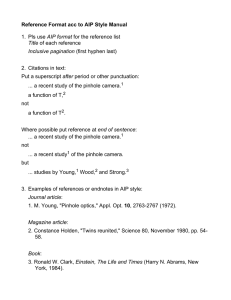photographic-image-formation-I.ppt

Photographic Image Formation I
Szymon Rusinkiewicz, Tim Weyrich: Technology in Art and Cultural Heritage .
Princeton Freshman Seminar 2006
Acknowledgment: some figures by B. Curless, E. Hecht, W.J. Smith, B.K.P. Horn, and A.
Theuwissen
Photographic Image Formation
Real world Optics Sensor
Dark
Room
Pinhole Camera
• Acquiring images using a pinhole camera?
Image plane
Pinhole
Object
Pinhole camera
• Use light-sensitive film at image plane
Image
Pinhole Camera
Pinhole Camera
Pinhole Camera
Pinhole Camera
• Limitations depending on size of aperture:
Image plane
Image
Pinhole
Object
Pinhole camera
• Aperture much too small: diffraction through pinhole
blurry image
Pinhole Camera Limitations
• Can we have sharp images , no diffraction , and enough light at the same time?
Pinhole Camera Limitations
• Can we have sharp images , no diffraction , and enough light at the same time?
• Optical lenses do the trick!
Lenses
• Focus a bundle of rays from a scene point onto a single point on the imager
• Increases aperture without loss of sharpness
Ideal “Thin” Lens Law
• Relationship between focal distance and focal length of lens:
1/ d o
+ 1/ d i
= 1/ f
Camera Adjustments
• Focus?
–
Changes d i
• Iris?
–
Changes aperture
• Zoom / wide-angle?
–
Changes f and sometimes d i
–
Changes field of view
Focus and Depth of Field
• For a given d i
, “perfect” focus at only one d o
• In practice, OK for some range of depths
–
Circle of confusion smaller than a pixel
• Better depth of field with smaller apertures
–
Better approximation to pinhole camera
Field of View
• Depends on
–
Focal length of lens
–
Size of imager
–
Object distance?
• Photographic film
• CCD sensors
• CMOS chips
Sensors
Photographic Film
• Until recently the most common imager
• Silver salts or dyes darken under light exposure
• After fix step , image prints from negative
• Multiple film layers with filters: color images
MOS Capacitors
• MOS = Metal Oxide Semiconductor
Gate (wire)
SiO
2
(insulator) p -type silicon
MOS Capacitors
• Voltage applied to gate repels positive “holes” in the semiconductor
+10V
+ + + + + +
Depletion region
(electron “bucket”)
MOS Capacitors
• Photon striking the material creates electron-hole pair
Photon +10V
+ + + + + +
+
Charge Transfer
• Charge has to be transported off the chip to digitizing circuits
• Charge-coupled devices (CCD) build bucketchains:
CMOS Imagers
• Recently, can manufacture chips that combine photosensitive elements and processing elements
• Benefits:
–
Partial readout
–
Signal processing
–
Eliminate some supporting chips
low cost
Where do all the colors come from?
• Electrons don’t have a color…
Where do all the colors come from?
• Electrons don’t have a color…
• We can separate images into red, green, and blue:
3-Chip Cameras
• Prisms separate incoming light into red, green, and blue wavelengths
• One detector chip for each color
Single-Chip Cameras
• A single detector chip
• Small color filters in front of each pixel
• Images have to be processed for perpixel RGB
Bayer mosaic
Foveon Technology
• Layered sensor
• Similar structure to photographic film
Development Process
• Classical film requires development in dark room
• What about digital images?
Development Process
• Classical film requires development in dark room
• Digital images require Digital Darkroom
• Mapping of sensor data to pixel values
• Mapping defined by
–
Contrast & intensity (dynamic range)
–
Gamma
– Simulated film (grain, solarizatoin, …)


